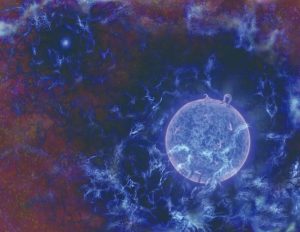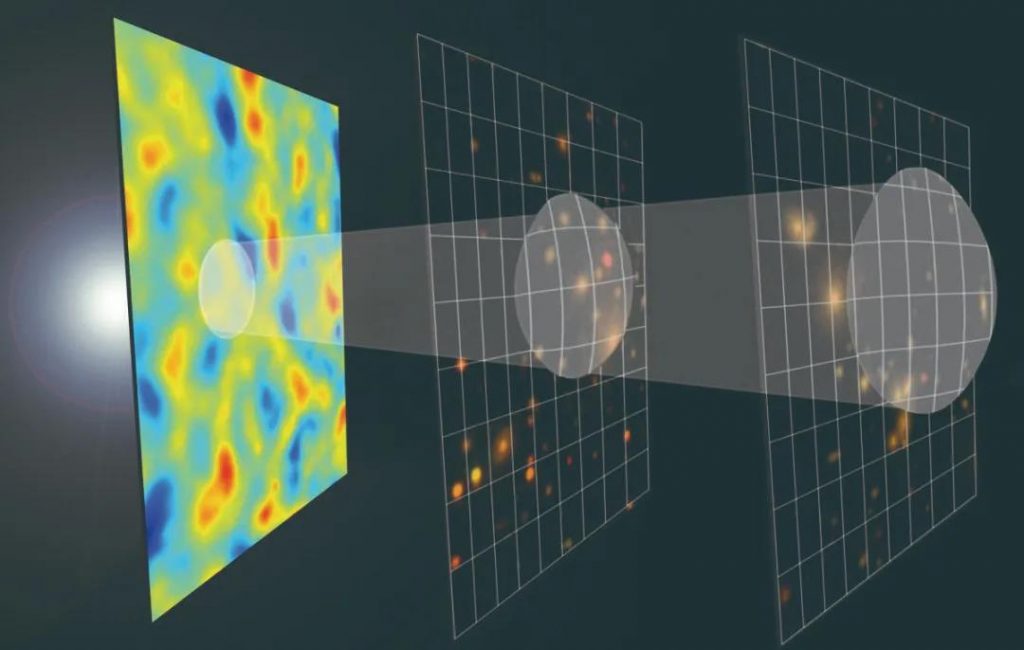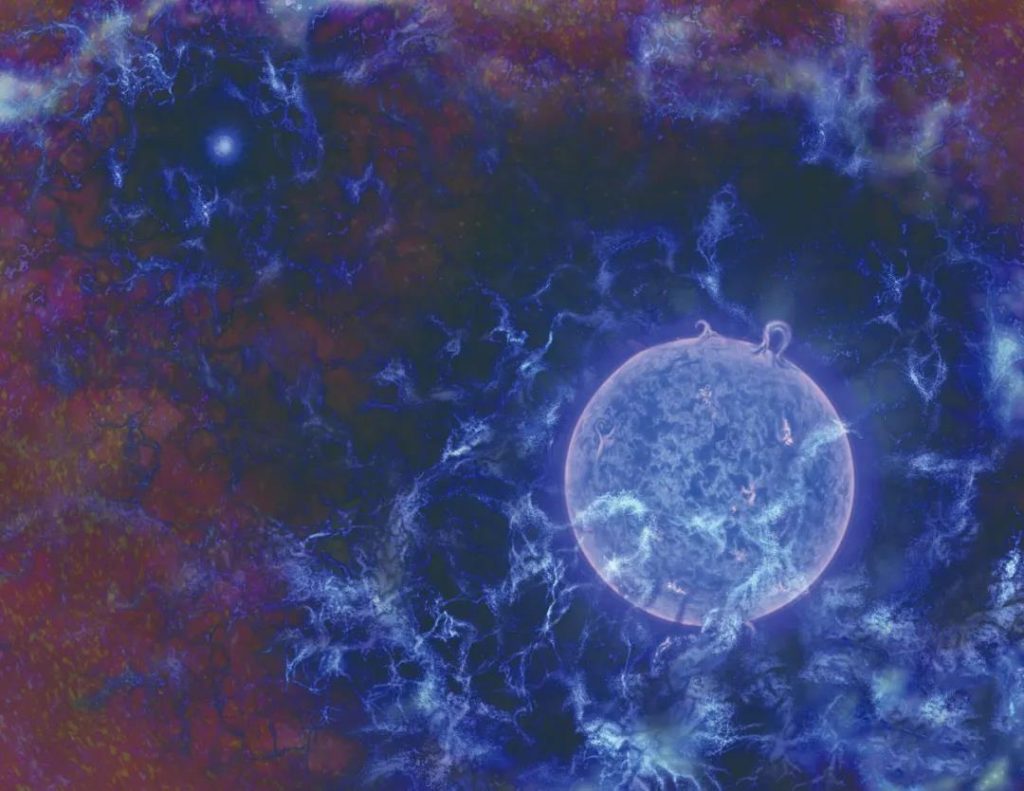
Half a million years after the Big Bang, the hot radiation gradually subsided and the temperature slowly dropped. At this time, matter in the universe began to dominate, neutral atoms could not be ionized, and gravity began to work.
From then on, it took about 50 to 100 million years for the universe to form the first star.
Different areas began to be unevenly hot and cold
When a neutral atom is first formed, it indicates that photons stop scattering from free electrons, because free electrons only appear when the atom is ionized in the form of plasma; since there is nothing to scatter, light radiation in space at this time Moving at the speed of light.
These light radiations come from all directions and are almost completely uniform, basically 2970.8 K, but some places are slightly higher, reaching about 2971.0K, and some places are slightly lower, about 2970.6K. These subtle differences are important factors leading to the production and evolution of stars.

The first star in the universe may not form until 50 to 100 million years after the Big Bang.
In fact, these lights are uniform at the beginning (all at exactly the same temperature), but they are slightly different due to their location.
The density of some areas is exactly the same as the average density of the entire universe, but the density of some areas is slightly higher or slightly lower than the average density. Areas with slightly lower density, because there is less material in them, the gravitational force is also lower. When a photon leaves the area, the gravitational potential it has to fight against is smaller and the energy lost is less. The photon in this area will become higher than the average temperature; and the area with slightly higher density has more matter in it. Therefore, there is more gravity to fight against, and as the photon climbs, it loses more than average energy, so it becomes colder overall, or less energy.
Next, these slightly denser regions will attract more and more matter under the action of gravity until stars are formed.
Gravity starts to gather
In the universe, all objects are attracting each other, whichever has the greatest mass, it will preferentially attract all other surrounding objects. In the ever-expanding universe, areas with higher density will attract any matter in nearby areas with lower density.
In this sense, gravity is an out-of-control force. The more matter it attracts, the stronger the gravity, and the more successfully it can bring more matter into it.
As the universe cools, gravity begins to gather matter into clusters and eventually gathers together. As more and more matter is attracted together, its growth rate becomes faster and faster.
However, it is worth noting that at this time, there is not only matter and gravity in the universe, but also radiation (existing in the form of photons). While atomic matter and dark matter attract massive particles under gravity, they also attract radiation to areas with higher density.
However, radiation is different from matter in that it has pressure. Because of the radiation pressure, these gas clouds (clumps gathered together) will not collapse due to gravity.
This pressure will also control the growth rate of matter. Even in a matter-dominated universe, as long as the radiation still exists, the density of matter can only increase slowly-for millions of years.
Gravitational collapse and nuclear fusion
Three million years after the birth of the universe, the temperature dropped from 3000K to 800K, and the radiation eventually cooled to the point where human eyes could not see it. With the decrease of radiation pressure, the growth rate of the mass of matter gradually increases, and the density becomes larger and larger.
All matter clumps follow a simple rule: when the temperature of the universe drops to half of its original value, it will grow rapidly and its density will increase; when the temperature of the universe drops to a certain critical threshold (about 100K), its The growth rate will increase rapidly, and once it grows to a density that is 68% higher than the average density, it will begin to collapse.

While the universe is expanding uniformly, there are always small local density fluctuations, which enables the universe to form stars, galaxies and galaxy clusters over time. Adding local density inhomogeneities to a uniform background is the starting point for understanding what the universe is like today.
At 50 million years after the Big Bang, the denser clumps had transitioned to a stage of rapid growth and began to shrink at an extremely rapid rate. In the end, it reached the point where it could collapse, forming a hot and huge object, and igniting the nuclear fusion at its core.
These huge objects are almost entirely composed of hydrogen and helium. Except for a small amount of lithium (approximately one billionth of all elements in the universe), there is no heavier element at all. When gravitational collapse occurs, energy is trapped in these objects, causing them to become hot. When the temperature exceeds the critical threshold of about 4 million K, nuclear fusion begins.
The first stars light up the universe
This nuclear fusion occurs in all areas of higher density, and it is the first time.
When nuclear fusion began, the gravitational force that continued to increase the mass of these objects was suddenly offset by the internal radiation pressure. At the subatomic level, protons fuse in a chain reaction to form deuterium, then tritium or helium-3, then helium-4, and each process releases energy.
As the core temperature rises, the energy released also increases, and as a result, it will continue to counteract the increasing mass of gravity.
When these first hydrogen-helium chain reactions began to take place, a star was born.
The first batch of stars formed in the universe, just like modern stars, grew rapidly due to gravity. However, unlike modern stars, there are no heavy elements in them. Without heavy elements, it is difficult to radiate energy, so they cannot be cooled quickly. Because it needs to be cooled to collapse, this means that only larger, heavier clumps can form stars.
Therefore, the average mass of the first stars we formed in the early universe was 10 times that of the sun, and the largest stars were thousands of times the mass of the sun (by comparison, the average mass of stars today is only 40% of the sun).
The peak of the radiation emitted by the first stars is different from that of the sun. The sun mainly emits visible light, and these stars mainly emit ultraviolet light. Ultraviolet photons are photons with higher energy that can not only sunburn the human body, but also ionize matter-they have enough energy to knock electrons out of the atoms they encounter.
Reionization and Planetary Disk
Since most matter in the universe is composed of neutral atoms, when the first stars emerge from these massive gas clouds, the first thing light (ultraviolet light) does is to collide with the neutral atoms around them, and ionize these atoms: split into nuclei and free electrons.
This process is called “reionization” because this is the second time an atom has been ionized in the history of the universe (the first time was before the initial formation of neutral atoms).
However, since most stars take a long time to form, there are not enough ultraviolet photons to ionize most of the matter in the universe.

There are no heavy elements in the first batch of stars formed in the universe. Without heavy elements, it is difficult to radiate energy, so they cannot be cooled quickly.
For hundreds of millions of years, neutral atoms firmly held the reionized atoms. The light emitted by the original star can’t travel far, it will be absorbed by neutral atoms throughout the universe. These atoms are absorbed and then ionized. Some of these ionized matter will become neutral atoms again and emit light.
The ionization of the first stars and the intense radiation pressure forced the formation of other stars to stop shortly after the beginning; most of the gas clouds that formed stars were blown away and evaporated (ionized) by this radiation. The remaining material in these gas clouds collapsed into the protoplanetary disk, but without any heavy elements, it could only form diffuse giant planets-as we see today. It is impossible for the first stars to be formed to have planets attached to them, because the radiation pressure will destroy the planets.
Stars that continue to form
50 million to 100 million years after the Big Bang, the universe has completely broken the uniformity and formed a huge cosmic web under the action of the gravitational force of the universe.
The initially denser areas continue to expand, and over time these areas attract more and more material. At the same time, those areas with a density lower than the average density began to fail to retain the substances in them, thus giving them to areas with higher density.
As a result, the denser areas first form stars, the medium-density areas may take 500 million years, the lower-density areas may take more than a billion years, and the least dense areas will eventually form stars, but that is Billions of years later.
Comments